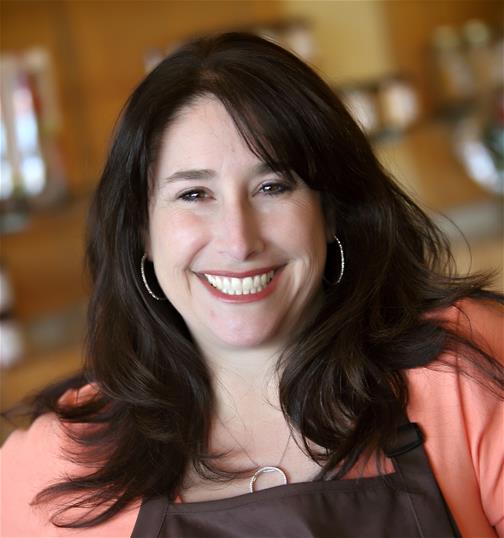Chef Debbie Kornberg shares suggestions for creating an enjoyable and meaningful virtual seder during pandemic
SAN DIEGO, Calif., March 1, 2021 — If there is one person who knows how to bring more pizzazz to the seder table this Passover, it’s San Diego resident Debbie Kornberg. The wife of Rabbi David Kornberg of Congregation Beth Am, Jewish National Fund-USA’s (JNF-USA) San Diego board president and owner of Spice + Leaf, a company specializing in curated spice blends that brings Mediterranean flavor and flare to home cooking, Debbie has been offering “Spice It Up with Deb” cooking classes, both in-person and online, since long before the pandemic and will be leading a live, free, virtual Passover cooking class, open to anyone in the country, featuring some of her favorite holiday recipes on March 17.

Additionally, Debbie and Rabbi David Kornberg are accustomed to hosting seders of all shapes and sizes. Whether you’re having a small intimate crew this year or gathering with family over Zoom, here are her top ten tips for a successful seder.
1. Be prepared!
Passover is not the time to wing it! To take the guesswork out of the preparations, Debbie has a notebook where she keeps her holiday menus, shopping lists, and details about how many guests have attended previous seders, so that she can go back and see how much food to purchase and prepare.
2. Plan a menu that makes sense
If you’re having guests, remember to plan for vegetarians and to take other dietary needs and food sensitivities into account to make sure that everyone has something to eat.
There are many ways to put a new twist on traditional elements of the seder. “My husband’s family is from eastern Europe, so they use potatoes as the karpas and my family is fourth-generation American, so we use parsley,” Debbie says. “We started out using both, and then we branched out to incorporate other foods like cucumbers, jicama, and radishes.” Debbie says that any vegetable that grows from the ground is fair game (as opposed to something like an avocado, which grows from a tree). These bouquets also do double-duty: they make beautiful centerpieces and - once the blessing is said (the ending is “Borei Prei Ha’adamah”), you can continue to eat the different vegetables throughout the seder.
4. Spice up your charoset
Experimenting with different kinds of charoset can be a real treat. Where Ashkenazi charoset usually consists primarily of apples, nuts, wine, and cinnamon, Sephardic and Mizrahi versions may include a variety of dried fruits (dates, figs, apricots, raisins) and spices like ginger, cardamom, allspice, and nutmeg - don’t be afraid to try something new!
5. Give them something to talk about
When it comes to telling the story of Passover, Debbie says her family always plans ahead to ensure a lively discussion that will include both the kids and adults at the table. “One year, my family prepared a trial for the ‘wicked child’ [one of the four children discussed in the text of the Haggadah],” she says, “The kids acted as the defense and prosecution lawyers and had to make the case for why the wicked child was innocent or guilty, with the adults acting as the jury.”
6. Don’t be shy when it comes to singing
One of Debbie’s favorite parts of the seder is the music, which extends far beyond what you will find in a Haggadah. She says you don’t have to be a great singer to participate, and that her family enjoys singing everything from traditional Passover songs, to freedom songs like “If I Had a Hammer,” to a version of “These Are a Few of My Favorite Things,” with Passover lyrics.
7) Choose the right Haggadah
Choosing a Haggadah that’s right for you and your family sets the tone for the whole seder. By shopping around and finding one that resonates with you, you’ll feel more inclined to have a robust, meaningful seder.
8) Have a wine tasting
There’s no reason why you have to drink the same wine all night. Use the four cups of wine throughout the seder to try a variety of wines. You might want to have a selection of Israeli wines, or different color wines, or some with bubbles (and don’t forget the grape juice for children and any guests who don’t drink alcohol). Check out JNF-USA’s online marketplace for some great selections of Israeli wines.
9) Bring the fun
Having activities for the children at the table will help keep them busy and also make a festive “tablescape!” Debbie suggests Passover sticker books, toy plague sets, and Legos or other small building blocks for constructing pyramids.
10) Make the most of Zoom
While we can all agree that there is no replacement for being together in person, Debbie suggests optimizing some of the features on Zoom to make your seder a truly interactive experience, such as taking polls or using breakout rooms to divide into small discussion groups (for example, one for kids and one for adults), before coming back together as a group.
To hear more of Debbie’s Passover tips and to learn how to cook new mouthwatering recipes for your seder, register for her free live, virtual cooking class on March 17 at jnf.org/cookingwithdeb.
SPACE IS LIMITED. RESERVE YOUR SPOT TODAY.
Missed a previous JNF virtual event or interested in signing up for future events? Visit https://www.jnf.org/menu-3/videos/ondemand.
###
Media Contact:
Jennifer Milton
561.447.9733 x 875
About Jewish National Fund-USA
JNF-USA is the leading philanthropic organization for Israel that supports critical environmental and nation building activities in Israel’s north and south. Through its One Billion Dollar Roadmap for the Next Decade, JNF-USA is developing new communities in the Galilee and Negev, connecting the next generation to Israel, and creating infrastructure and programs that support ecology, individuals with special needs, and heritage site preservation.